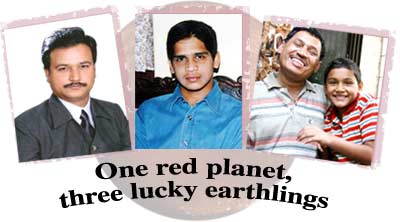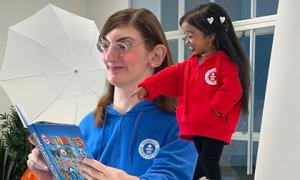
Had Ryan Cardoza been a few years older and attended the same school as Madhukar Venkatesh Reddy, he might have got on a plane to California next month. Instead, the nine year old from suburban Mumbai large-heartedly gifted the trip to his father.
Madhukar, 15, a Class X student of New Horizon Public School, Bangalore, was bewildered when the National Geographic channel called to say that his on-the-spot essay on human settlements on Mars had won him a trip to NASA's Jet Propulsion Laboratory in Pasadena, California.
In Indore, Madhya Pradesh, schoolteacher Manoj Parmar frequently watched the National Geographic channel with his students. Parmar, 32, had dreamt about life on Mars since he was in Class IX. He teaches biology and bio-technology to high-school students at the Choithram School and often used shows from the channel as teaching aids.
One January evening, while he was on duty at the school hostel, he watched the Mission Mars show on National Geographic. A contest following the programme presented a question: name the two Mars rovers. Parmar SMS-ed the answers, Spirit and Opportunity, to the number shown on the screen.
In June, the channel announced that Parmar, Madhukar and a certain Michael were the lucky winners chosen to go where few have gone before -- NASA's sophisticated Jet Propulsion Laboratory in California, where the Mars rovers were conceived and engineered. The winners, who will fly to California in August, will also visit Hollywood and other attractions.
MICHAEL Cardoza, a former Indian Navy engineer and now a human resources manager at a call centre, usually left his cell phone near his television when he got back from work. His children Ryan and Ashlene, 15, frequently squabbled over the remote -- she to watch MTV and Friends, and he for National Geographic and his favourite cartoons. The cell phone was also a bone of contention. The kids fought to play games on it. But Cardoza never imagined the two gadgets would soon share an unusual kinship.
When Ryan, who attends the Bombay Scottish School near his home in Powai, chanced upon the Mission Mars contest on the National Geographic channel, he pounced on his Dada's cell. In addition to the question about the two Mars Rovers, another flashed on the screen: How long is one day on Mars?
"Twenty-four hours and 37 minutes!" exclaimed Ryan. Without waiting for the three options that flashed on the screen, he SMS-ed the answer before the promo had finished playing.
A month passed. Parmar and Madhukar consigned the contest to the backburner.
Until the phone rang. The National Geographic channel informed Parmar and Madhukar that they had been selected for the second round of the contest.
Madhukar suddenly had cold feet. "To be honest, I thought I would back out," he said from his home in Bangalore. "I felt I didn't stand a faint chance of winning and it would be silly to try something like this."
He had never been considered the brightest in his circle. He only wrote essays for class assignments. He never entered contests voluntarily because he always felt "there were children far better at writing than I am".
His parents saddled him with encyclopaedias to read; his teachers heaped his desk with reading material. Madhukar, who reluctantly glanced through some of it, turned up one nippy February morning at the contest venue in Bangalore to write an impromptu essay.
The organisers gave the contestants a situation: imagine a time, 1,000 years hence, when human beings are forced to evacuate Earth and emigrate to Mars. Which five living or 10 non-living things would the contestants take along, and why? Also, how would they set about colonising Mars?
"I wrote from imagination about what was lacking on earth, like peace and prosperity," says Madhukar. "I said we must establish a perfect society on Mars that would give us these conditions. I used no knowledge of Mars and its conditions at all. Instead, I wrote about what we should do to see there were no dacoits and burglars on Mars. I suggested ways in which we could bring about a green revolution on Mars and grow all kinds of food for ourselves."
Meanwhile, Parmar travelled to Mumbai where he was posed similar questions: how could a human society be established on Mars using 10 living and non-living things?
Parmar chose three males and three females, and selected two kinds of bacteria -- chemo-autotrophic bacteria, colourless organisms that produce oxygen with the help of other inorganic substances -- and photo-autotrophic bacteria, which produce oxygen with the help of light.
Food, Parmar hypothesised, would come from growing lichens, a plant-like organism that is in fact a result of two different forms of life -- an alga and a fungus -- coming together in a symbiotic relationship. The alga, with its chlorophyll, takes care of photosynthesis, while the fungus absorbs moisture and nutrients from the soil, or the substrate on which it grows. With the help of bio-technology, Parmar said, the fungi can be made edible. His dream machine, a photosynthesiser, would help produce both food and oxygen for the human community on Mars.
Only 50 percent of the schoolteacher's essay dealt with science. He devoted the last two quarters to social values and the ethics of human society on Mars. There should be a proper ratio of males and females on the red planet, he said. There would also be no religion. 'By that time human society would have advanced enough to understand that human society needs only one religion -- the religion of humanity -- to thrive,' he wrote.
When he had finished, he knew he stood a chance.
IN JUNE, Cardoza was taken aback when a cheery voice on the phone told him he had won a contest on a television channel he barely watched. But the real winners back home -- his kids -- were gleeful.
Parmar and Madhukar, who received similar calls, were overjoyed.
Winning the contest has already made a difference to Madhukar. "My friends and relatives have come closer to me now," says the lanky schoolboy, who was thus far perceived as a basketball player with little scholastic aptitude. "Everyone in school smiles at me."
"We expect this trip will make a big difference to Madhukar as it will give him wonderful exposure," says his mother Geeta Reddy. "We want to give him the best education possible and then leave him free to do whatever he wants with his life."
Sandwiched between sisters Keerti and Shruti, Madhukar is the second of three children of N C Venkata Reddy, a civil contractor, and his homemaker wife. He wants to take his mother with him on his trip to the US and, like any youngster, hopes to visit Disneyland.
Little Ryan would have loved to visit NASA, too. "It's a once in a lifetime thing," he says, his face falling. But the regulations specified that the contestants had to be 18 or older except for those selected in the school category, like Madhukar.
"I am ready to bear the additional expense of taking him along," says Cardoza. "He's the deserving person, not me." The organisers recently informed him that they had no objection to his son accompanying him. But there was a stumbling block: Ryan cannot enter NASA.
"I need to find out why," says Cardoza. "If it is a NASA rule, there's no point taking him along."
Parmar, who rears snakes in the school laboratory and builds nest-boxes for birds, hopes the visit to NASA will make him a better teacher and get him a promotion. "It has made me a popular teacher in Indore and Ujjain," he says. "But some of my friends at the Indian Institute of Science, Bangalore, believe I should work there as a scientist."
Parmar welcomes the idea. "Teaching is good, but you reach out to a small number of people. I want my work to reach the nation."
In the picture: Manoj Parmar; Madhukar Reddy, photographed by Om Prakash; Michael Cardoza with son Ryan. Photographed by Jewella C Miranda
Image: Uday Kuckian








More from rediff